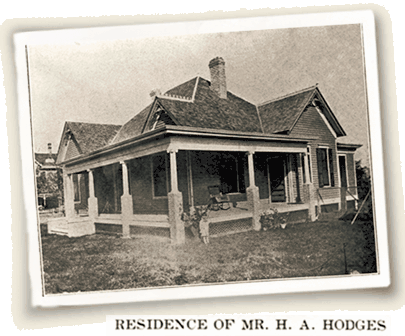The H.A. Hodges House
The H.A. Hodges House is a Georgetown Historical Society property. It was built in or about 1904 for Mr. Hodges by Charles S. Belford, a Master Builder and owner of a local lumber company. Mr. Hodges worked for Mr. Belford at his lumber company as the bookkeeper; he later became the Williamson County Auditor.
The fact that Mr. Belford built the Hodges House is significant in that there is the Belford National Register Historic District in Georgetown. The Belford District comprises an eight-block area and represents the evolution of architectural forms and development patterns from the 1870’s to the 1930’s. 73 of the District’s 81 structures are at least half a century old, and most of them were constructed by Mr. Belford’s successful and well-reputed lumber company.
Mr. Belford insisted on exactness and high quality, and he supervised the construction himself. Wearing a suit and derby, he made his rounds carrying an umbrella, a piece of chalk and a plumb bob. His versatility and competence as a builder are evident in the varying styles, scales, and complexity of the well-crafted buildings which endure today.
The Hodges House is a one-story wood frame dwelling with many original features, including the front door and sidelights, three coal-burning fireplaces with tile surrounds, a beautifully carved rear door, wavy-glass windows, transoms, and extensive moldings and trim, none of which had ever thankfully been painted. A majority of the ceilings in the House are original long leaf pine, and the wood walls were covered in batting and fabric. While the ceilings were left as is, the batting and fabric was removed from the wood walls, covered with 1/4″ drywall and faux finished with a leather-look by a local artist.
West Short purchased Hodges House in 2006 for the express purpose of renovating it for use as his law practice. The extensive renovation took 7 months and included the installation of central heat and air conditioning, new bathrooms with fixtures in keeping with the period of the House, enclosing a screened sleeping porch for additional work space, and repairing extensive termite damage.




